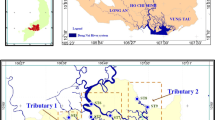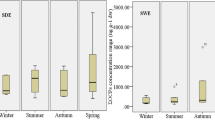Abstract
Organochlorine pesticides (OCPs), viz. β-hexachlorocyclohexane (β-HCH), γ-HCH, aldrin, dieldrin, endrin, heptachlor, endosulfan-I, endosulfan-II, heptachlor endoepoxide, heptachlor exoepoxide, mirex, dicofol, o,p′-dichlorodiphenyltrichloroethane (o,p′-DDT), p,p′-dichlorodiphenyltrichloroethane (p,p′-DDT), dichlorodiphenyldichloroethane (DDD), and dichlorodiphenyltrichloroethylene (DDE) and 12 other physicochemical parameters were measured in surface sediments from River Chenab during two sampling seasons (summer and winter, 2007) to evaluate spatial and temporal trends of sediment pollution. Hierarchical agglomerative cluster analysis identified three groups of sites based on spatial similarities in physicochemical parameters and OCP residual concentrations. Spatial discriminant function analysis (DFA) segregated 14 parameters, viz. dicofol, endosulfan-I, heptachlor endoepoxide, dieldrin, DDD, DDE, endosulfan-II, o,p′-DDT, p,p′-DDT, pH, electrical conductivity (EC), Cl−1, total P (%), and silt, which explained 96% of total variance between spatial groups. γ-HCH was the most frequently detected (63%) pesticide, followed by DDD (56%). The ratio of DDTs to their metabolites indicated current input and anaerobic biodegradation. Temporal DFA highlighted aldrin, heptachlor endoepoxide, Cl−1, total P, and EC as important variables which caused variations between summer and winter. DDTs were relatively more prevalent as compared to other OCPs in the sediments samples during both seasons. DDT metabolites were detected at greater frequencies and concentrations in winter, whereas DDT isomers were more prevalent in summer sediment samples. Factor analysis identified agricultural and industrial activities as major sources of sediment OCP contamination. Concentrations of γ-HCH, heptachlor endoepoxide, dieldrin, and DDTs (isomers and metabolites) in all sediment samples were well above interim sediment quality guidelines (ISQGs) and probable effect limits (PEL) given by Canadian Sediment Quality Guidelines (CSQGs).






Similar content being viewed by others
References
Allen, S. E., Grimshah, H. M., Parkinson, J. A., & Christopher, Q. (1974). Chemical analysis of ecological material (p. 751). New York: Blackwell, Wiley.
AOAC (Association of official Analytical Chemists). (1995). Official methods of analysis. Washington, DC: Association of Analytical Chemists.
Babu, R., Imagawa, T., Tao, H., & Ramesh, R. (2005). Distribution of PCBs, HCHs and DDTs, and their ecotoxicological implications in Bay of Bengal, India. Environment International, 31, 503–512.
Bakan, G., & Ariman, S. (2004). Persistent organochlorine residues in sediments along the coast of mid-Black Sea region of Turkey. Marine Pollution Bulletin, 48, 1031–1039.
Bossi, R., Laesen, B., & Premazee, G. (1992). Polychlorinated biphenyl congeners and other chlorinated hydrocarbons in bottom sediments cores of Lake Garden (Italy). Science of Total Environment, 121, 77–93.
Brady, N. C., & Weil, R. R. (1996). The nature and properties of soils (11th ed.). Upper Saddle River, New Jersey: Van Hoffman.
Brasher, A. M. D., & Wolf, R. H. (2004). Relation between land use and organochlorine pesticides, PCBs, and semi-volatile organic compounds in stream sediments and fish on the Island of Oahu, Hawai. Archives of Environmental Contamination and Toxicology, 46, 385–398.
CCME (Canadian Council of Ministers of the Environment). (1999). Canadian sediment quality guidelines for the protection of aquatic life: Summary tables. Canadian environmental guidelines, Winnipeg, Manitoba; 1999 (update 2002).
Cirmo, C. P., Driscoll, C. T., & Bowes, K. (2000). Chemical fluxes from sediments in two Adirondack wetlands, effects of an acid-neutralization experiment. Soil Science Society of America Journal, 64, 790–799.
Doong, R. A., Peng, C. K., Sun, Y. C., & Liao, P. L. (2002a). Composition and distribution of organochlorine pesticide residues in surface sediments from the Wu-Shi River estuary, Taiwan. Marine Pollution Bulletin, 45, 246–253.
Doong, R. A., Sun, Y. C., & Liao, P. L. (2002b). Distribution and fate of organochlorine pesticide residues in sediments from the selected Rivers in Taiwan. Chemosphere, 48, 237–246.
Economic Survey of Pakistan. (2005–2006). Finance division, government of Pakistan, Islamabad. http://www.finance.gov.pk/survey/sur_chap_05-06/02-Agriculture.PDF.
Fernandez, M. A., Alonso, C., Gonzalez, M. J., & Hernandez, L. M. (1998). Occurance of organochlorine insecticides, PCBs and PCB congeners in waters and sediments in the Ebro River (Spain). Chemosphere, 38, 33–43.
Glynn, P. W., Rumbold, D. G., & Sendaker, S. C. (1995). Organochlorine pesticide residues in marine sediment and biota from the northern Florida reef tract. Marine Pollution Bulletin, 30, 397–402.
Hites, R. K., & Day, H. R. (1992). Unusual persistence of DDT in some western USA soils. Bulletin of Environmental Contamination and Toxicology, 48, 259–264.
Hong, H., Chen, W., Xu, L., Wang, X., & Zhang, L. (1999). Distribution and fate of organochlorine pollutants in Pearl River estuary. Marine Pollution Bulletin, 12, 376–382.
Hong, H. S., Xu, L., Zhang, L. P., Chen, J. C., Wong, Y. S., & Wan, T. S. M. (1995). Environmental fate and chemistry of organic pollutants in the sediments of **amen and Victoria Harbors. Marine Pollution Bulletin, 31, 229–236.
Ioannis, K. K., Dimitra, G. H., & Triantafyllos, A. A. (2006). The status of pesticide pollution in surface waters (Rivers and lakes) of Greece. Part I. Review on occurrence and levels. Environment Pollution, 141, 555–570.
Jabbar, A., Masud, S. Z., Parveen, Z., & Ali, M. (1993). Pesticide residues in cropland soils and shallow groundwater in Punjab Pakistan. Bulletin of Environmental Contamination and Toxicology, 51, 268–273.
Jan, M. R., Shah, J., Khawaja, M. A., & Gul, K., (2008). DDT residue in soil and water in and around abandoned DDT manufacturing factory. Environmental Monitoring and Assessment. doi:10.1007/s10661-008-0415-2 (in press).
Kalantzi, Q. I., Alcock, R. E., Joneston, P. A., Santillo, D., Stringer, R. L., Thomas, G. O., et al. (2001). The global distribution of PCBs and organochlorine pesticides in butter. Environmental Science and Technology, 35, 1013–1018.
Kishimba, M. A., Henry, L., Mwevura, H., Mmochi, A. J., Mihale, M., & Hellar, H. (2004). The status of pesticides pollution Tanzania. Southern and Eastern Africa Network for Analytical Chemists, 64, 48–53.
Leonard, R. A. (1990). Movement of pesticides into surface waters. In H. H. Cheng (Ed.), Pesticides in soil environment: Processes, impacts and modeling (pp. 303–349). Madison, WI: Soil Science Society of America.
Leung, C. C. M., Jefferson, T. A., Hung, S. K., Zheng, G. J., Yeung, L. W. Y., Richardson, B. J., et al. (2005). Petroleum hydrocarbons, polycyclic aromatic hydrocarbons, organochlorine pesticides and polychlorinated biphenyls in tissues of Indo-Pacific humpback dolphins from south China waters. Marine Pollution Bulletin, 50, 1713–1744.
Lopez, N. G., Otero, R. R., Grande, B. C., Gandara, J. S., & Gonzalez, B. S. (2005). Occurrence of organochlorine pesticides in stream sediments from an industrial Area. Archives of Environmental Contamination and Toxicology, 48, 296–302.
Luo, X., Mai, B., Yang, Q., Fu, J., Sheng, G., & Wang, Z. (2004). Polycyclic aromatic hydrocarbons (PAHs) and organochlorine pesticides in water columns from the Pearl River and the Macao harbor in the Pearl River Delta in South China. Marine Pollution Bulletin, 48, 1102–1115.
Malik, R. N., Rauf, S., Mohammad, A., Eqani, S. A. M. A. S., & Ahad, K. (2010). Organochlorine residual concentrations in cattle egret from the Punjab Province, Pakistan. Environmental Monitoring and Assessment. doi: 10.1007/s10661-010-1390-y.
Malik, R. N., & Zeb, N. (2009). Assessment of environmental contamination using feathers of Bubulcus ibis L., as a biomonitor of heavy metal pollution, Pakistan. Ecotoxicology, 18, 522–536.
Metson, A. J. (1956). Methods of chemical analysis for soil survey samples. New Zealand Department of Scientific and Industrial Research, Soil Bureau Bulletin, Vol. 12.
Minh, N. H., Minh, T. B., Iwata, H., Kajiwara, N., Kunisue, T., Takahashi, S., et al. (2007). Persistent organic pollutants in sediments from Sai Gon-Dong Nai River Basin, Vietnam: Levels and temporal trends. Archives of Environmental Contamination and Toxicology, 52, 458–465.
Munshi, A. B., Detlef, S. B., Schneider, R., & Zuberi, R. (2004). Organochlorine concentrations in various fish from different locations at Karachi Coast. Marine Pollution Bulletin, 49, 597–601.
Nikolskii, N. N. (1963). Practical soil science (p. 240). Washington D.C: Technical Services US Department Commerce.
Nowell, L. H., Caple, P. D., & Dileanis, P. D. (1999). Pesticides in sediments and aquatic biota. Distribution, trends, and governing factors. Pesticides in hydrologic system series. Boca Raton, FL: CRC.
Peris, E., Requena, S., Guardia, M., Pastor, A., & Carrasco, J. M. (2005). Organochlorine pesticides in sediments from the Lake Albufera of Valencia (Spain). Chemosphere, 60, 1542–1549.
Phuong, P. K., Son, C. P., Sauvian, J. J., & Tarradellas, J. (1998). Contamination by PCBs, DDTs, and heavy metals in sediments of Ho Chi Minh city’s canals, Viet Nam. Bulletin of Environmental Contamination and Toxicology, 60, 347–354.
Qadir, A., Malik, R. N., & Husain, S. Z. (2008). Spatio-temporal variations in water quality of Nullah Aik-tributary of the River Chenab, Pakistan. Environmental Monitoring and Assessment, 140, 43–59.
Robert, G. P., & Frederick, R. T. (1995). Introductory soil science laboratory manual (p. 120). New York: Oxford University Press.
Saqib, T. A., Naqvi, S. N., Siddiqui, P. A., & Azmi, M. A. (2005). Detection of pesticide residues in muscles, liver and fat of 3 species of Labeo found in Kalri and Haleji lakes. Journal of Environmental Biology, 26, 433–438.
Sarkar, S. K., Bhattacharya, B. D., Bhattacharya, A., Chatterjee M., Alam A., Satpathy K. K., & Jonathan M. P. (2008). Occurrence, distribution and possible sources of organochlorine pesticide residues in tropical coastal environment of India: An overview. Environment International EI-01747 (in press).
Sarkar, A., Nagarajan, R., Chaphadkar, S., Pal, S., & Singbal, S. Y. S. (1997). Contamination of organochlorine pesticides in sediments from the Arabian Sea along the west coast of India. Water Research, 31, 195–200.
Singh, B., Singh, Y., & Sekhon, G. S. (1995). Fertilizer-N use efficiency and nitrate pollution of groundwater in develo** countries. Journal of Contaminant Hydrology, 20, 167–184.
Tariq, M. I., Afzal, S., Hussain, I., & Sultana, N. (2007). Pesticides exposure in Pakistan: A review. Environment International, 33, 1107–1122.
Tehseen, W. M., Hansen, L. G., Wood, S. G., & Hanif, M. (1994). Assessment of chemical contaminants in water and sediment samples from Degh Nala in the province of Punjab, Pakistan. Archives of Environmental Contamination and Toxicology, 26, 79–89.
Vashchenko, M. A., Syasina, I. G., & Zhadan, P. M. (2005). DDT and hexachlorocyclohexane in bottom sediments and the liver of Barfin Plaice Pleuronectes pinnifasciatus from Amur Bay (Peter the Great Bay, Sea of Japan). Russian Journal of Ecology, 36(1), 57–61 (Translated from Ekologiya, 1, 64–68).
Wei, S., Wang, Y., Lam, J. C. W., Zheng, G. J., So, M. K., Yueng, L. W. Y., et al. (2008). Historical trends of organic pollutants in sediment cores from Hong Kong. Marine Pollution Bulletin, 57, 758–766.
Yang, R. Q., Lv, A. H., Shi, J. B., & Jaing, G. B. (2005). The level and distribution of organochlorine pesticides (OCPs) in sediments from the Haihe River, China. Chemosphere, 61, 347–354.
Zhang, Z. L., Hong, H. S., Zhou, J. L., Huang, J., & Yu, G. (2003). Fate and assessment of persistent organic pollutants in water and sediment from Minjiang River estuary, Southern China. Chemosphere, 52, 1423–1430.
Zhang, G., Min, Y. S., Mai, B. X., Sheng, G. Y., Fu, J. M., & Wang, Z. S. (1999). Time trend of BHCs and DDTs in a sedimentary core in Macao estuary, Southern China. Marine Pollution Bulletin, 12, 326–330.
Zhou, R., Zhu, L., Yang, K., & Chen, Y. (2006). Distribution of organochlorine pesticides in surface water and sediments from Qiantang River, East China. Journal of Hazardous Materials, 137, 68–75.
Acknowledgments
The first author thanks the Higher Education Commission (HEC) for providing financial support under the Indigenous 5,000 fellowship program towards his PhD. We also acknowledge the Pakistan Wetland Program (PWP) for providing transportation during fieldwork. Efforts of research students of EBL, QAU during exhaustive fieldwork are gratefully acknowledged.
Author information
Authors and Affiliations
Corresponding author
Rights and permissions
About this article
Cite this article
Eqani, S.AMAS., Malik, R.N. & Mohammad, A. The level and distribution of selected organochlorine pesticides in sediments from River Chenab, Pakistan. Environ Geochem Health 33, 33–47 (2011). https://doi.org/10.1007/s10653-010-9312-z
Received:
Accepted:
Published:
Issue Date:
DOI: https://doi.org/10.1007/s10653-010-9312-z




